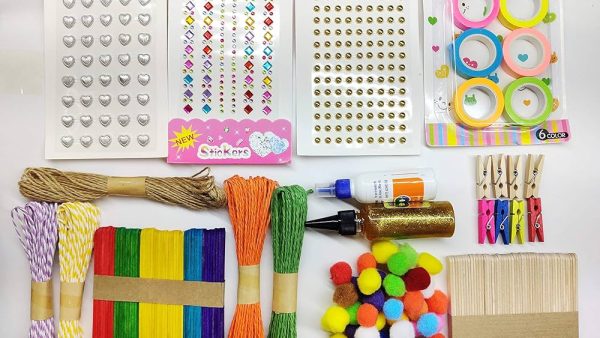Watercolors
Table of Contents:
- Why Should You Start Using Watercolors?
- Types of Watercolor Paints
- Watercolor Supplies
- Watercolor Techniques
- Mixing Watercolors
- FAQs
- Why Should You Start Using Watercolors?
Experimenting with watercolors might be daunting. However, if done right, watercolors are artistically amazing and can be mastered with time. Below are a few reasons to why you should start using watercolors in your next art piece:
- It is a very versatile medium for different types of drawing styles.
- You do not need a lot of art supplies to start painting with watercolors, essentially what you need is paper, water, and your colors.
- Watercolors have several price points that can fit any budget.
- Types of Watercolor Paints

There are three basic forms of watercolors available in stores.
Tubes: Watercolor tubes have a paste-like consistency. They are already moist in the tube itself.
Pans: Watercolors in pan form are dry pigments separated in different small compartments.

Pencils: Watercolor pencils are usually used to draw the initial sketch, as they can be removed with a moist brush or cloth. But you may also finish your entire painting using only them.

Tip: if you are not exactly sure of which type to get, consider buying a beginner set of each one to see which one you like best. Beginner sets are much cheaper than professional level paints.
- Watercolor Supplies
Other than the paints themselves, you will need the following:

Brushes:
There are three main factors you need to consider when choosing the best brushes for you. These are the type of bristles, size, and shape.

- Bristles: Natural hair brushes are great for watercolors, but they can be quite expensive. If you are on a tight budget, you can find high-quality brushes with synthetic hairs that can last a long time if you take care of them correctly.
- Size: A variation of paint brushes is always nice. However, you do not need a big collection of brushes, because some of them are actually versatile. For example, you can use a medium round brush for big and fine details on your work of art, particularly if you applied the right technique and pressure.
- Shape: Different shapes of brushes can be used to achieve a number of effects. Square or angular brushes for example can be used for making straight or precise strokes, in addition to filling large sections in color. Additionally, a round brush is must-have. It is great for details and applying a wash of color on your paper. Also, you can use a liner or pointy brushes for fine details and executing drawing lines.

Tip: You can also find brushes with handles that you can fill water into. When you squeeze the handle, the brush will release a small amount of water that you can use for wetting your paint or paper.

Paper:
Watercolor paper is durable and does not absorb the pigment, but instead, it lets the paint sit on top until it dries. You can find watercolor paper in the following forms:
- Sheets: Individual sheets that you can cut to size.

Pads: A pad of paper of somewhat lower quality stuck together by a wire binding. This is great for travel, painting outdoors, or practicing.

- Blocks: Watercolor papers glued together from one edge, which you have to insert a knife into to remove the painting once it is dry. This is useful if you do not wish to tape your paper onto the surface to avoid warping.
Palette:
Watercolor palettes come in two types, either plastic or ceramic. Ceramic palettes are usually of higher quality since plastic ones will eventually become stained. However, plastic is much lighter and easier to hold.
Tip: Choose a palette with deep “wells” or the individual little pots which hold the color. This is essential so your colors will not end up bleeding into each other.
Container for Water:
You cannot paint using watercolors without water! So, make sure to have a jar or cup with water in it. It is better that the container is clear so you can see how murky the water is in order to change it.

Tip: You can also use a spray bottle to wet your watercolor palette.
Soap: In order to clean your brushes and to maintain them in a good condition, you will need a mild or organic soap, preferably in liquid form. Also, you can find “artist soap” that is specifically made to clean paintbrushes.
Additional Supplies: Paper towels for drying the water off brushes; a pencil and eraser if you plan to sketch first; painters’ tape to prevent your paper from warping onto itself by taping it to your table; and spray varnish to seal your finished painting to protect it from external conditions.
- Watercolor Techniques
- Wet on Wet: This technique is achieved by wetting the paper first with a wash of water then using watercolors on top. It is great for painting landscapes, skies, or soft flowy scenes.
Wet-on-Dry: This technique is used for precise and defined shapes. It is achieved by applying watercolor on dry paper.

- Building Color: This happens when you let your first wash of color dry and then add another layer on top of the areas that you want to make more vibrant or darker. This is achieved by using different values of the same color.
- Gradients: This is very similar to the previous technique. However, it is mostly used to slowly transition from one color to the other. It could be very useful for painting the sky during sunset.
Tip: When creating gradients, make sure to use colors that are close on the color wheel, and go well together. This is to make it look harmonious and to avoid muddy colors.
- Mixing Watercolors
Some artists find watercolors very convenient because they mix so well, so they only need to have the basic colors to mix them with each other and get different results. Watercolor incorporates very well; all you need is to wet the first color and move it with your brush on your palette and then add the second color with the same brush then mix. You can get purple by mixing red and blue, orange by mixing yellow and red, and green by mixing yellow and blue, and much more if you know simple mixing combinations.
Tip: You should always mix more paint than you think you need because it is very hard to mix the exact same color twice.
FAQs
Why is watercolor considered hard to learn?
Watercolor painting has always been so popular, but it does not mean that it is the easiest medium to deal with. Painting with watercolors can be difficult because it is somewhat unpredictable. Additionally, your mistakes will be harder to fix, as the fluid nature of watercolors makes it hard to control.
How do you keep watercolor paintings from fading?
Sunlight plays a major role in fading or discoloring watercolors. You can avoid that by covering your painting with a sheet of filtered glass or acrylic. And naturally, any contact with water or moisture will cause your paints to smear or run. In this case, you can also use a varnish for sealing the painting from any environmental elements.






